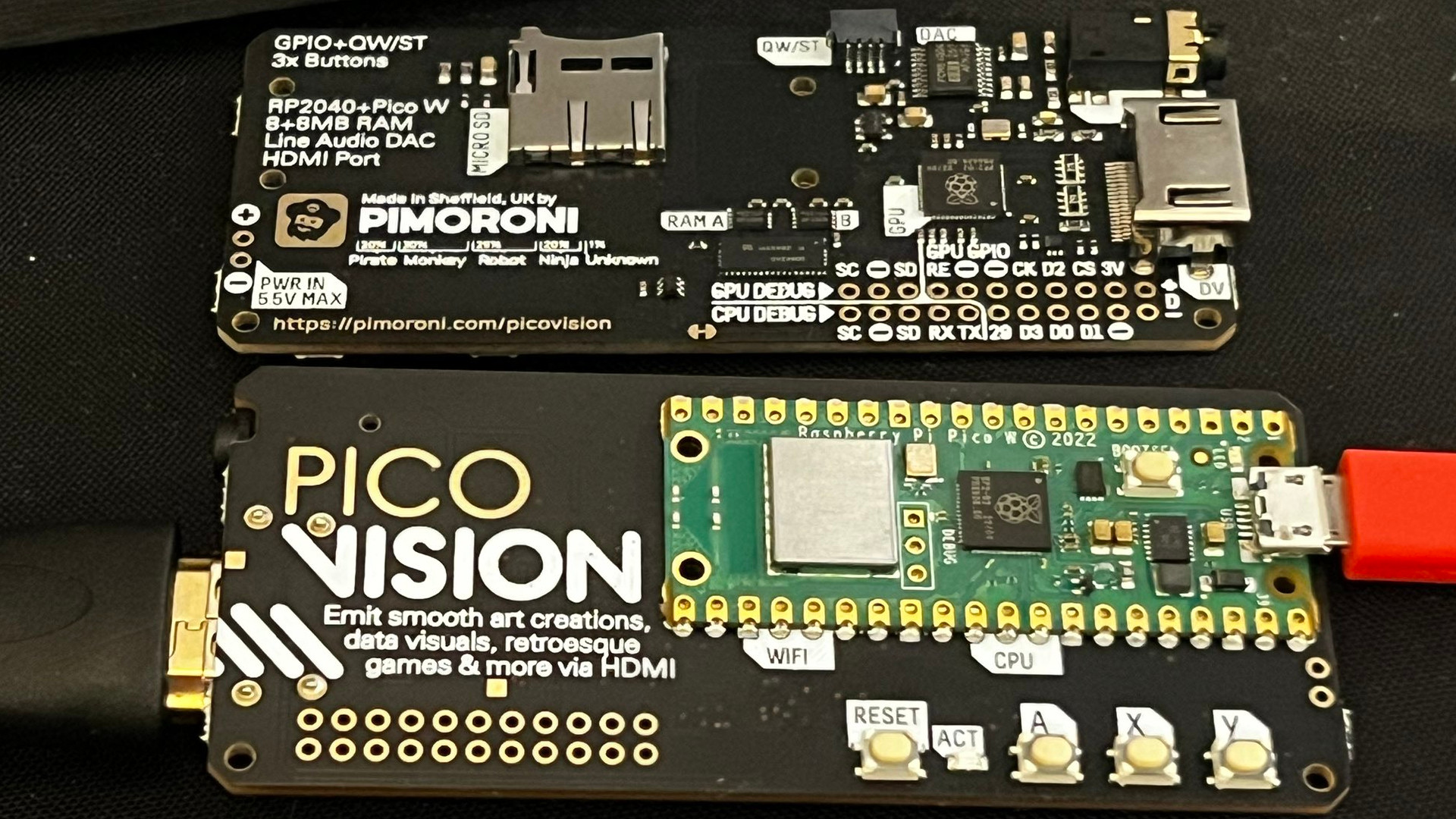Pimoroni's Pi-Powered 'Pico Vision' Nears Completion

Squeezing the Raspberry Pi Pico's RP2040 into another breakout board, UK-based Pimoroni is working on Pico Vision. The board, according to Pimoroni software developer Phil "Gadgetoid" Howard is "A dual RP2040 “CPU” and “GPU” HDMI stick for … doin’ graphics stuff on big screens." We first heard about this product way back in March 2023 during our weekly The Pi Cast show.
Stealin’ @jankmammal’s photo again for this 🤣A dual RP2040 “CPU” and “GPU” HDMI stick for … doin’ graphics stuff on big screens. https://t.co/y50FNYIG5D pic.twitter.com/rAYuBWxCUHSeptember 11, 2023
In the tweet, which has an image from fellow Pimoroni employee @jankmammal, Howard shows a panel of eight Pico Vision boards. Each board has a Raspberry Pi Pico W surface mount soldered to it, and buttons for user input. On the back we can see an additional RP2040 SoC along with a DV (HDMI) port, audio via a DAC, micro SD and a QW/ST (Qwiic / Stemma QT) connector.
The silkscreen also suggests that there is "8 + 8MB RAM" and — while this isn't onboard RAM directly for the RP2040 — according to Howard, "they are the front and back buffer, and basically swap dynamically between chips. The 'CPU' draws a frame (and various other supporting data) into a buffer, and then requests that it's flipped to the "GPU" which pulls out that data into its RAM and generates the HDMI signal." Howard also confirmed that the RAM is there for sprite image data instead of directly accessible to MicroPython.
Storage comes via micro SD — necessary for the large amounts of sprite and audio / visual data. An amount that would quickly overwhelm the 2MB Flash commonly found with the RP2040. GPIO access is limited to QW/ST connections and a few GPIO pins broken out via the CPU and GPU debug pins.
| SoC | 2 x RP2040 Arm Cortex M0+ Dual Core at 133 MHz |
| RAM | 264KB per RP2040, 8+8MB for sprite buffers |
| Storage | 2MB Flash / Micro SD |
| Connectivity | Infineon CYW43439 2.4 GHz Wi-Fi with onboard antenna |
| Ports | HDMI, Micro SD (Power and Data), Audio, QW/ST |
| GPIO | QW/ST, CPU and GPU debug pins. |
| Row 6 - Cell 0 | Row 6 - Cell 1 |
Quick regression test 🤣 pic.twitter.com/ZvJSq6lXulSeptember 12, 2023
Pico Vision is designed for outputting video to a large screen via HDMI, but that isn't its sole purpose. On the silkscreen we see "Emit smooth art creations, data visuals, retroesque games and more via HDMI" and a series of videos from Howard show simple 8-bit games being played.
This, along with Howard's work on PicoGraphics — a simplified means to working with sprites and images on the RP2040 — brings a little of the "bedroom coder" scene back. (In the 1970s and 80 there was a massive bedroom coder scene in the US and UK, a scene which bore many of the classic games from now revered names.) These coders made games using exceptionally limited resources — many times less powerful than the Raspberry Pi Pico. Could Pico Vision enthuse another bedroom coding scene?
We don't know how much it will be or when Pico Vision will be on the market, but we have reached out to Pimoroni for more details and will be getting a board in for review.
Get Tom's Hardware's best news and in-depth reviews, straight to your inbox.

Les Pounder is an associate editor at Tom's Hardware. He is a creative technologist and for seven years has created projects to educate and inspire minds both young and old. He has worked with the Raspberry Pi Foundation to write and deliver their teacher training program "Picademy".
-
bit_user ReplyEach board has a Raspberry Pi Pico W surface mount soldered to it
I wonder how much production volume it would take before it's cheaper just to solder all of the Pico's components directly onto the baseboard.
